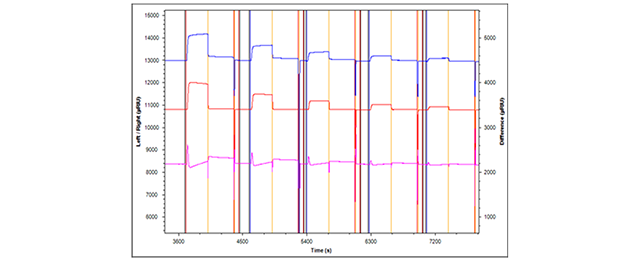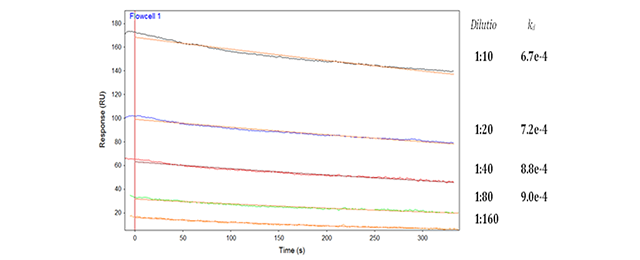Serum IgG antibody binding to recombinant Ebola virus glycoprotein (GP) immobilized on carboxymethyl dextran surface
Introduction
Antibody affinity, a measurement of antibody quality following vaccination, may be an important contributing factor in anti-viral immunity [1]. Avidity enzyme-linked immunosorbent assays (ELISAs) have traditionally been used to determine affinity of serum antibodies. Here, we present a surface plasmon resonance-based protocol for determining antibody affinity of protein-specific antibodies in human serum. Experimental conditions and results are presented, as well as considerations for assay set-up.
Experimental
The experimental conditions for this assay are summarized below:
- Ligand: EBOV-GP
- Analyte: Serum containing anti-EBOV-GP antibodies
- Analyte dilutions: 1:10, 1:20, 1:40, 1:80, 1:160
- Association time: 5 min at 10 μl/min
- Dissociation time: 6 min at 50 μl/min (flow rate was increased reduce the time needed for 10% dissociation).
- Regeneration solution: 10 mM glycine, pH 2.1
- Regeneration time: 15 s
Results
The 2SPR Dual Channel System monitors antibody-antigen binding interactions in real time with parallel monitoring of sample and reference channels. Purified recombinant EBOV-GP was immobilized onto a carboxymethyl dextran sensor chip surface to approximately 2500 μRIU, which allows EBOV-GP-specific antibodies to be detected while minimizing the risk of rebinding during dissociation. Raw data from five injections of serum antibodies is presented in Figure 1. Using serum samples resulted in a high background and bulk shift that is relative to the dilution factor (that is, more diluted serum samples have lower background and bulk shift, as shown in the figure). Even considering the background, specific binding interactions can still be measured, which allows the user to be able to reproducibly study off rates.
In Figure 2, the dissociation portion of the reference subtracted binding curves is presented, alongside affinity values (kd). Since the aim is to characterize the antibodies based on their dissociation rates, the focus is only on that part of the kinetic curve. The kd values were calculated using a simple bimolecular model in Scrubber2 (Biologic Software). When each serum dilution was fit as a separate sample (Figure 2), there was good similarity between the kd values calculated for more concentrated samples, but coupled with the low binding levels observed, the results for the sample diluted1:160 suggest that this may be too high of a dilution factor for serum samples under these assay conditions. When the curves are fit globally, the kd value is calculated to be 7.1e-4.


Conclusions
The results presented involve the analysis of serum samples, rather than purified polyclonal or monoclonal antibodies. Being able to work with serum samples, without performing pre-preparation, can save both time and materials. This capability of the Reichert SPR machine allows samples to be used in their natural form and therefore reduce the chance of potential bias introduced due to sample preparation. Our experience has shown that we have acceptable reproducibility for serum samples obtained from laboratory animals or from a homogeneous human population, especially when blanked against a similar (negative) control.
Finally, when working with a large number of samples from a variety of individuals, it may be useful to purify IgG antibody from serum to minimize problems with reproducibility due to inter-individual variation. Working with purified IgG antibody would also remove the high background observed for serum samples. This would guarantee that the results reported can be attributed to a specific antibody class.
Reference
[1] S. Khurana, N. Verma, J. W. Yewdell, A. K. Hilbert, F. Castellino, M. Lattanzi, G. Del Giudice, R. Rappuoli, and H. Golding, "MF59 Adjuvant Enhances Diversity and Affinity of Antibody-Mediated Immune Response to Pandemic Influenza Vaccines," Sci. Transl. Med., vol. 3, no. 85, p. 85ra48, Jun. 2011.